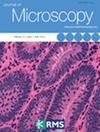用于烟草高尔基体中人类糖基化酶定位的亚组织细胞分辨率成像技术
IF 1.5
4区 工程技术
Q3 MICROSCOPY
引用次数: 0
摘要
植物细胞是一种能够生产具有经济和治疗意义的蛋白质的系统,可用于多种应用领域,与细菌或酵母等现有宿主相比,植物细胞被认为是一种更安全的生产系统。然而,植物不能像哺乳动物细胞那样进行蛋白质修饰。这可能会影响植物生产的人类治疗药物的蛋白质功能。要克服这一障碍,可以创建一个基于植物的系统,该系统能够对感兴趣的蛋白质进行 "人源化",从而使合成的植物生产的蛋白质具有与哺乳动物系统相同的糖基化特征。为此,在植物细胞中表达了参与N-连接糖基化的人类糖基化酶(HuGEs):N-乙酰葡糖胺基转移酶IV和V(GNTIV和GNTV)、β-1,4-半乳糖基转移酶(B4GALT1)和α-2,6-氨酰基转移酶(ST6GAL)。要使这些酶执行逐步糖基化功能,它们需要定位到高尔基体晚期的小室中。这是通过一种蛋白质靶向策略实现的,即用植物特异性结构域取代哺乳动物高尔基体靶向结构域(细胞质-跨膜-干(CTS)区)。利用高分辨率动态共聚焦显微镜,我们发现 GNTIV 和 GNTV 成功靶向了内侧高尔基细胞,而 ST6GAL 和 B4GALT1 则靶向了反式高尔基细胞。植物细胞是一种很有前途的人类治疗系统,例如酶替代疗法中使用的蛋白质。与哺乳动物细胞培养、细菌或酵母等现有表达系统相比,植物细胞可以提供更安全、更便宜的替代品。不过,影响治疗蛋白质功能的一个重要因素是人体细胞特有的蛋白质修饰。然而,植物进行蛋白质修饰的方式与人体细胞不同。因此,需要对植物细胞进行基因改造,以模仿人类的蛋白质修饰模式。在这里,我们展示了四种人类糖基化酶在植物细胞中的表达情况,这四种酶是进行 N-连接糖基化所必需的。此外,由于这些蛋白质修饰是在类似工厂生产线的细胞中进行的,因此人类糖基化酶必须按照正确的顺序放置在正确的细胞分区中。这项工作在高尔基体中进行。高尔基体由几个确定的堆栈组成,分别称为顺高尔基体堆栈、中高尔基体堆栈和反高尔基体堆栈。为了使蛋白质发挥正确的功能,人类糖基化酶中的两种需要置于内侧-高尔基体堆栈中,另外两种则置于反式-高尔基体堆栈中。我们利用活体植物细胞中的高分辨率激光显微镜,在这里展示了人类糖基化酶在细胞内被送往正确的高尔基体堆栈。这是改造植物细胞以生产人类治疗药物的第一步。本文章由计算机程序翻译,如有差异,请以英文原文为准。
Suborganellar resolution imaging for the localisation of human glycosylation enzymes in tobacco Golgi bodies
Plant cells are a capable system for producing economically and therapeutically important proteins for a variety of applications, and are considered a safer production system than some existing hosts such as bacteria or yeasts. However, plants do not perform protein modifications in the same manner as mammalian cells do. This can impact on protein functionality for plant‐produced human therapeutics. This obstacle can be overcome by creating a plant‐based system capable of ‘humanising’ proteins of interest resulting in a glycosylation profile of synthetic plant‐produced proteins as it would occur in mammalian systems.For this, the human glycosylation enzymes (HuGEs) involved in N‐linked glycosylation N‐acetylglucosaminyltransferase IV and V (GNTIV and GNTV), β‐1,4‐galactosyltransferase (B4GALT1), and α‐2,6‐sialyltransferase (ST6GAL) were expressed in plant cells. For these enzymes to carry out the stepwise glycosylation functions, they need to localise to late Golgi body cisternae. This was achieved by a protein targeting strategy of replacing the mammalian Golgi targeting domains (Cytoplasmic‐Transmembrane‐Stem (CTS) regions) with plant‐specific ones. Using high‐resolution and dynamic confocal microscopy, we show that GNTIV and GNTV were successfully targeted to the medial‐Golgi cisternae while ST6GAL and B4GALT1 were targeted to trans‐ Golgi cisternae.Plant cells are a promising system to produce human therapeutics for example proteins used in enzyme replacement therapies. Plants can provide safer and cheaper alternatives to existing expression systems such as mammalian cell culture, bacteria or yeast. An important factor for the functionality of therapeutic proteins though are protein modifications specific to human cells. However, plants do not perform protein modifications in the same manner as human cells do. Therefore, plant cells need to be genetically modified to mimic human protein modifications patterns. The modification of importance here, is called N‐linked glycosylation and adds specific sugar molecules onto the proteins.Here we show the expression of four human glycosylation enzymes, which are required for N‐linked glycosylation, in plant cells.In addition, as these protein modifications are carried out in cells resembling a factory production line, it is important that the human glycosylation enzymes be placed in the correct cellular compartments and in the correct order. This is carried out in Golgi bodies. Golgi bodies are composed of several defined stacks termed cis ‐, medial and trans ‐Golgi body stacks. For correct protein function, two of these human glycosylation enzymes need to be placed in the medial‐Golgi attacks and the other two in the trans ‐Golgi stacks. Using high‐resolution laser microscopy in live plant cells, we show here that the human glycosylation enzymes are sent within the cells to the correct Golgi body stacks. These are first steps to modify plant cells in order to produce human therapeutics.
求助全文
通过发布文献求助,成功后即可免费获取论文全文。
去求助
来源期刊

Journal of microscopy
工程技术-显微镜技术
CiteScore
4.30
自引率
5.00%
发文量
83
审稿时长
1 months
期刊介绍:
The Journal of Microscopy is the oldest journal dedicated to the science of microscopy and the only peer-reviewed publication of the Royal Microscopical Society. It publishes papers that report on the very latest developments in microscopy such as advances in microscopy techniques or novel areas of application. The Journal does not seek to publish routine applications of microscopy or specimen preparation even though the submission may otherwise have a high scientific merit.
The scope covers research in the physical and biological sciences and covers imaging methods using light, electrons, X-rays and other radiations as well as atomic force and near field techniques. Interdisciplinary research is welcome. Papers pertaining to microscopy are also welcomed on optical theory, spectroscopy, novel specimen preparation and manipulation methods and image recording, processing and analysis including dynamic analysis of living specimens.
Publication types include full papers, hot topic fast tracked communications and review articles. Authors considering submitting a review article should contact the editorial office first.
 求助内容:
求助内容: 应助结果提醒方式:
应助结果提醒方式:


